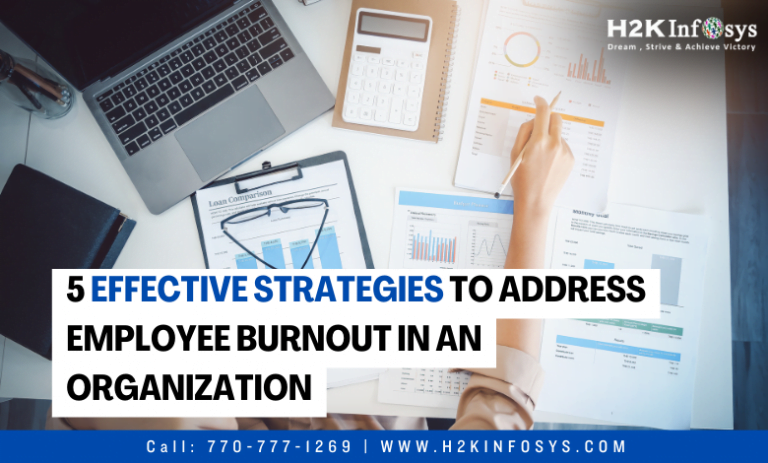According to a Gallup poll, 76% of workers say they have burned out at work at least occasionally, while 28% say they have burned out “very often” or “always.”
The aforementioned figures show that many workers face burnout-related problems on a regular basis. Unrealistic deadlines, ambiguous job requirements, lengthy work hours, etc. are the main causes of this. Reduced output, a high employee turnover rate, extended absence, etc., are possible outcomes.
However, employers can implement particular strategies that can assist decrease or prevent burnout and establish a healthy work environment. The bottom line of the company and team performance both benefit from this. To learn more, check out the business analyst certification course online.
Signs Of Employee Burnout In An Organization
Employee burnout is a phenomena brought on by ongoing working stress that has not been effectively managed, according to the World Health Organization. Moreover, emotions of depletion, tiredness, negativity, and decreased professional efficacy can be indicative of it.
Employees that are burned out perform poorly, produce lower-quality work, and tend to make more mistakes. Thus, before the problem worsens, companies need to notice the symptoms and take appropriate action.
The following are five crucial indicators of staff burnout to be aware of:
Increased absenteeism
Absenteeism among employees is frequently a sign of burnout. When employees feel worn out, fatigued, etc., they may take more unscheduled time off in order to manage burnout and reduce work-related stress. In addition, if they are not motivated to complete their job, they can attempt to avoid the workplace.
Lack of engagement
A sign of burnout is when workers get disinterested in their jobs, find it difficult to finish them on time, or commit mistakes frequently. They may stop caring about their everyday responsibilities or think their work is boring and pointless as a result of their extreme levels of stress and fatigue.
Lowered productivity and performance
Employee performance and productivity problems indicate that resources are continuously burning out in enterprises. Their total job efficiency suffers when they are unable to meet deadlines, feel overburdened by tasks, or lack direction.
Decreased personal well-being
Workers who are under constant strain at work are likely to see a decline in their physical well-being. It shows up as headaches, nausea, chest pain, panic attacks, and so on.
A rise in conflicts at work
Employee burnout is evident in symptoms such as sensitivity and impatience. Overwhelmed and tiredness might result in heightened emotional sensitivity and workplace disputes between co-workers.
Now that we are aware of some of the primary signs of employee burnout, let’s examine how an organisation might address it.
Five Ways To Prevent Employee Burnout
Staff burnout can negatively affect an organisation’s capacity to grow and maintain its financial stability if it is not handled. As a result, businesses need to put in place practical measures to reduce burnout and raise employee engagement.
Here are some strategies for overcoming burnout.
1.Set realistic deadlines considering employees’ leaves
Managers are required to create a work breakdown structure (WBS) with tasks and subtasks prior to starting a project. They will be able to evaluate the abilities, schedules, and quantity of resources needed to finish the project’s tasks thanks to it. This will assist managers in setting reasonable timelines and allocating resources according to the importance of the work at hand.
Before assigning resources to current or upcoming projects, managers should also have a look at the resource schedules and take into account their leave policies. This will guarantee that the projects are completed on schedule and assist staff in taking time off to refresh themselves, therefore reducing burnout.
2.Allocate resources based on skills & availability
Managers must evaluate each project’s potential before assigning resources. These include things like experience, competencies, availability, and skill levels. This will guarantee the effective distribution of resources, avoiding the assignment of people with inadequate or excessive skills to certain project tasks.
Furthermore, if resources are assigned to projects in accordance with their capabilities, under- or overallocation will be avoided, and a balanced workload will be maintained. This will lower stress levels and increase participation among staff members, lowering the possibility of burnout and guaranteeing the completion of the project successfully.
3.Monitor resource utilisation levels regularly
Managers need to monitor staff utilisation all the time to avoid disparities in workloads. Burnout results from consistently using resources excessively. This will directly lead to lower deliverable quality, unintended attrition, and problems with performance and productivity.
By anticipating and identifying over- or underutilization, managers can optimise workloads by implementing corrective actions. It will also assist managers in reallocating resources from non-billable chores to strategic and billable activities. In this manner, companies can enhance billable usage rates and avoid burnout.
4.Apply appropriate optimization techniques
Burnout results from allocating resources to projects or tasks that are above their capacity, which raises stress levels. As a result, managers need to use effective optimization strategies like resource levelling and smoothing to make sure that workers aren’t overworked or underpaid.
For projects with flexible deadlines, where start and finish dates can be changed based on employee availability and schedule, managers might apply resource levelling. On the other hand, they can use resource smoothing for urgent projects so that more workers can be hired or the workload of overworked resources can be divided. This will guarantee equitable allocation of the task and reduce the likelihood of burnout.
5.Build the right mix of contingent & permanent staff
During periods of peak demand, most businesses find it difficult to finish projects with the resources at hand. In order to meet the project deadlines, they consequently over allocate their current staff. On the other hand, overworking employees will negatively impact their output and eventually result in burnout.
Therefore, in order to lessen unneeded stress and free up staff members to concentrate better on high-value tasks or projects, firms can engage contingency workers or outsource the work to foreign workers. As a result, companies can reduce the expense of project resources, preserve workflow, and avoid employee fatigue.
Conclusion
Resources are the driving force for the success of a company. Therefore, it’s imperative that businesses look out for the welfare of their staff members and appreciate what they do. They will be inspired to work harder and produce better work as a result. Organisations can minimise burnout and raise the resource health index by putting into practice smart methods and cutting-edge resource management technologies. Check out the business analyst course online to learn more.




























